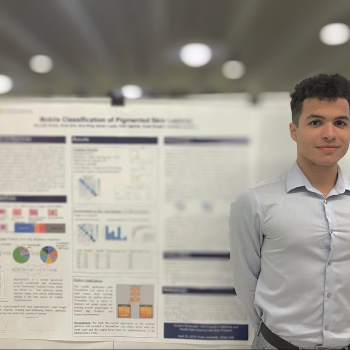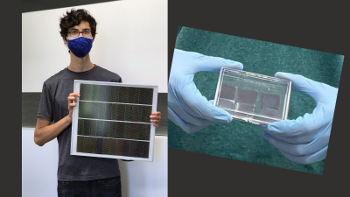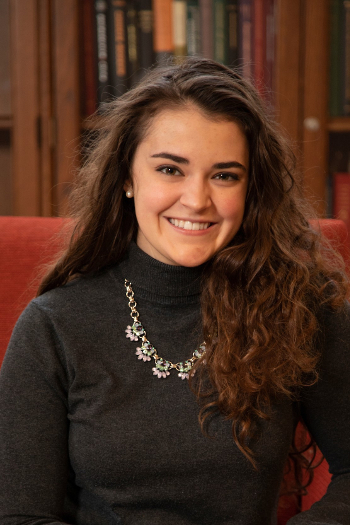Pursuing Research: 2021 Pratt Fellows
A glimpse into the projects pursued by three Pratt Undergraduate Research Fellows and the lessons provided by their experience

Using AI to model clinical neural stimulation. Creating new materials for flexible, thin-film solar cells. Understanding how protein mutations affect the structural properties of biological tissues. While the research topics pursued by Pratt Undergraduate Research Fellows are as diverse as Duke Engineering, the experiences gained are the same.
Pratt Fellows pursue intensive research projects for three semesters while receiving course credit as well as an opportunity for summer research. The experiences gained allow students to better understand what a career in research might be like, gain deep exposure to a specific field and develop a wide array of skills useful to whatever careers they may pursue after Duke.
“The Pratt Research Fellows program provides students with the opportunity to contribute to cutting-edge research topics, while gaining a deep understanding of advanced concepts within their fields,” said Carmen Rawls, assistant dean for advising and outreach for Duke Engineering. “These students grow as engineers and as researchers, prepared to tackle any challenges they will face in the future.”
Learn about the experiences of a few fellows below, and be sure to check out the full class of 2021 Pratt Fellows.
Adrian Lopez
Major: Electrical and Computer Engineering, Mathematics
Advisor: Angel Peterchev, associate professor of psychiatry and behavioral sciences, electrical and computer engineering, biomedical engineering, and neurosurgery
Project Title: Estimating Effects of tES on Neuron Models Using Deep Learning
What’s your project all about?
 Transcranial Magnetic Stimulation (TMS) is a promising new therapy for brain disorders and is FDA-cleared for the treatment of depression, obsessive-compulsive disorder, smoking addiction and migraine. TMS works by allowing psychiatrists to modulate brain activity in a specific region in the brain, for example the prefrontal cortex. However, the placement of the TMS coil on the patient’s head and the intensity of stimulation must be accounted for. There is no known “rational design” for these parameters, meaning that in order for parameters to be approved for clinical use, a clinical trial must be done.
Transcranial Magnetic Stimulation (TMS) is a promising new therapy for brain disorders and is FDA-cleared for the treatment of depression, obsessive-compulsive disorder, smoking addiction and migraine. TMS works by allowing psychiatrists to modulate brain activity in a specific region in the brain, for example the prefrontal cortex. However, the placement of the TMS coil on the patient’s head and the intensity of stimulation must be accounted for. There is no known “rational design” for these parameters, meaning that in order for parameters to be approved for clinical use, a clinical trial must be done.
Our goal is to be able to estimate the effects of TMS on brain cells (neurons) in the cortex through computational methods with the help of deep learning. By using realistic neuron models created by Aman Aberra, a PhD candidate in BME, we can run simulations where the neurons are exposed to different TMS parameters. Then, we use the data from those simulations to train deep neural networks—3D convolutional neural networks, specifically—to rapidly predict the effects. This cuts simulation time from around a week to about four minutes, with a very small amount of error.
There is another emergent therapy, called transcranial direct current stimulation (tDCS), that is approved for use in Europe. We are using deep neural networks to estimate this therapy’s effects on neurons as well. We plan to package this product into software that will allow neuroscientists and other specialists to design better therapies and learn more about the brain.
What’s your biggest takeaway from the Pratt Research Fellows program?
The biggest thing I’ll take away from this experience is how to do meaningful research as a member of a lab. The Peterchev Lab, specifically Dr. Angel Peterchev and Aman Aberra, have been very helpful in my development these past two years, and I’ve learned a lot from them. It taught me firsthand that a career in medical research is something that I want to pursue in the future.
Eric Chang
Majors: Mechanical Engineering, Computer Science
Advisor: David Mitzi, Simon Family Distinguished Professor of Mechanical Engineering and Materials Science
Project Title: Synthesis and Characterization of Selenium-Alloyed Bournonite CuPbSb(S1-xSex)3: A Prospective Semiconductor for Optoelectronic Applications
What’s your project all about?
 I’ve been studying a material called bournonite (CuPbSbS3) and its potential for thin-film solar cells and other energy applications. Thin-film solar cells are a newer version of solar cells that are lighter weight and more flexible than the first-generation version.
I’ve been studying a material called bournonite (CuPbSbS3) and its potential for thin-film solar cells and other energy applications. Thin-film solar cells are a newer version of solar cells that are lighter weight and more flexible than the first-generation version.
More specifically, I’ve synthesized a novel alloy (CuPbSb(S1-xSex)3), characterized its properties in powder form, and am working on synthesizing films and solar devices (i.e. solar cells) to analyze the efficiency of this new material.
What’s your biggest takeaway from the Pratt Research Fellows program?
The Pratt Research Fellowship has given me the opportunity to lead my own research project, use state-of-the-art equipment and processes, and collaborate with and learn from leaders in the field. By providing a thorough exposure to academic research, the experience has helped me develop a passion for research, and I’ll be continuing on to graduate school next year. Although I’ll be moving to a different research area, the program has equipped me with a set of research skills and experience that can be generally applied to any topic, allowing me to feel that I am well-prepared for graduate school and on a solid path toward a research career.
Taylor Huie
Major: Biomedical Engineering
Advisor: Brenton Hoffman, James L. and Elizabeth M. Vincent Associate Professor of Biomedical Engineering
Project Title: Examining N-cadherin’s Force Sensitive Interfaces
What’s your project all about?
 Within tissues, cell-cell adhesions enable structure formation, maintain mechanical integrity and facilitate signal transmission by resisting mechanical loads. These adhesions contain a protein called N-cadherin, which we genetically-encode with a FRET-based tension sensor for imaging. I worked to understand how mutations of this protein would affect the cell-cell adhesions and resulting physiological responses.
Within tissues, cell-cell adhesions enable structure formation, maintain mechanical integrity and facilitate signal transmission by resisting mechanical loads. These adhesions contain a protein called N-cadherin, which we genetically-encode with a FRET-based tension sensor for imaging. I worked to understand how mutations of this protein would affect the cell-cell adhesions and resulting physiological responses.
What’s your biggest takeaway from the Pratt Research Fellows program?
I am so incredibly thankful for the mentorship and acquired skills from my last three years of working in the Hoffman lab. I have learned a great deal about the science of cellular and molecular mechanobiology, but am most thankful for my training in efficient scientific problem solving—something I know I will apply in my future career.
